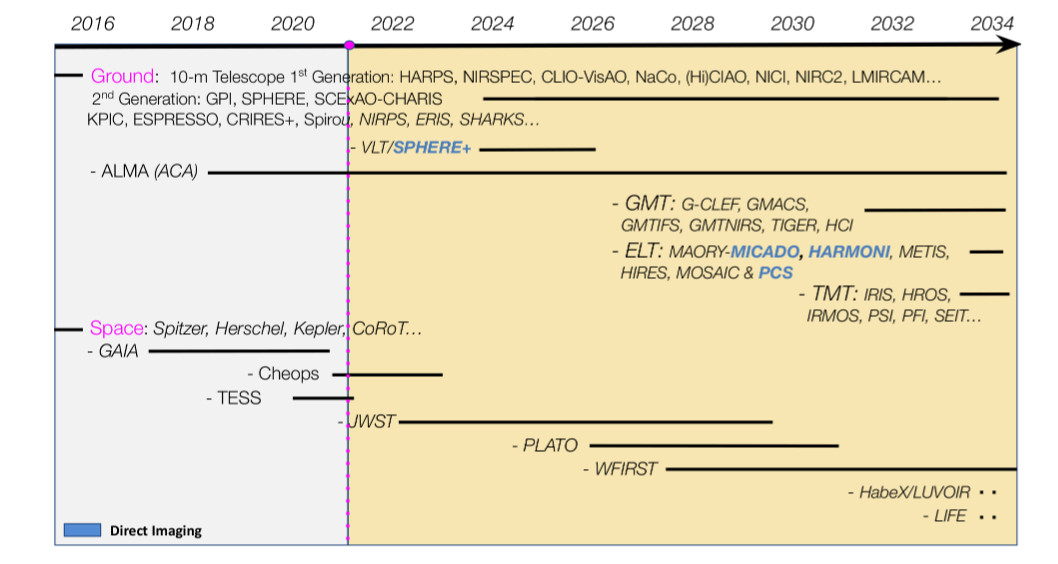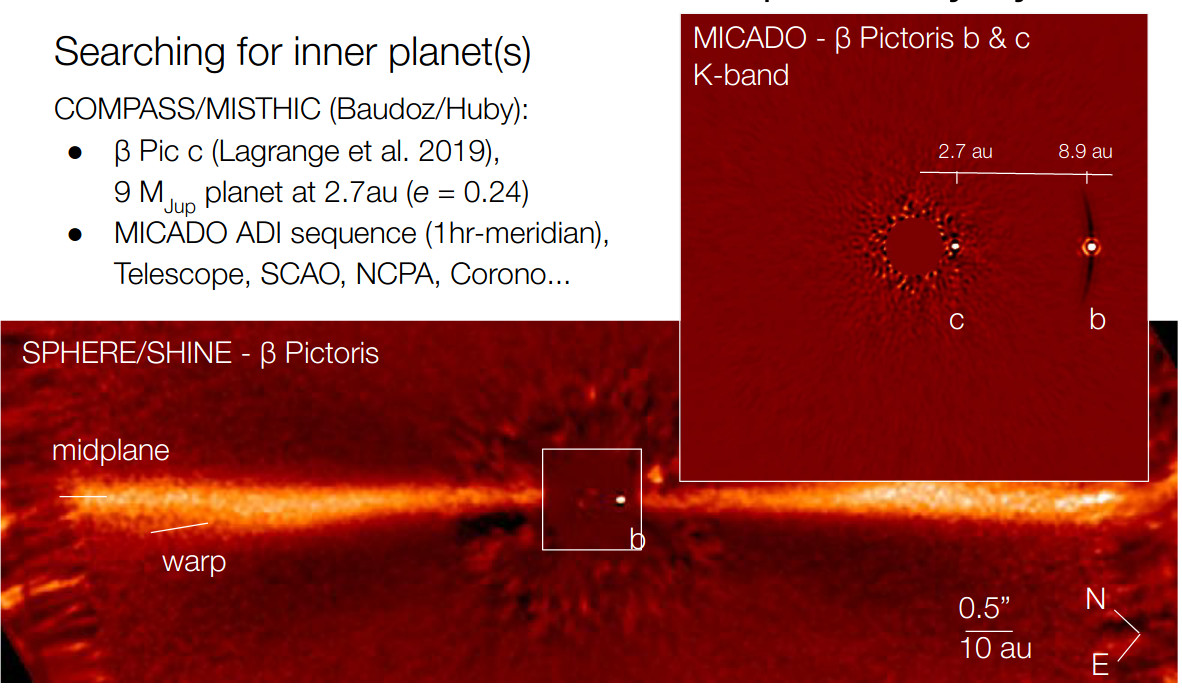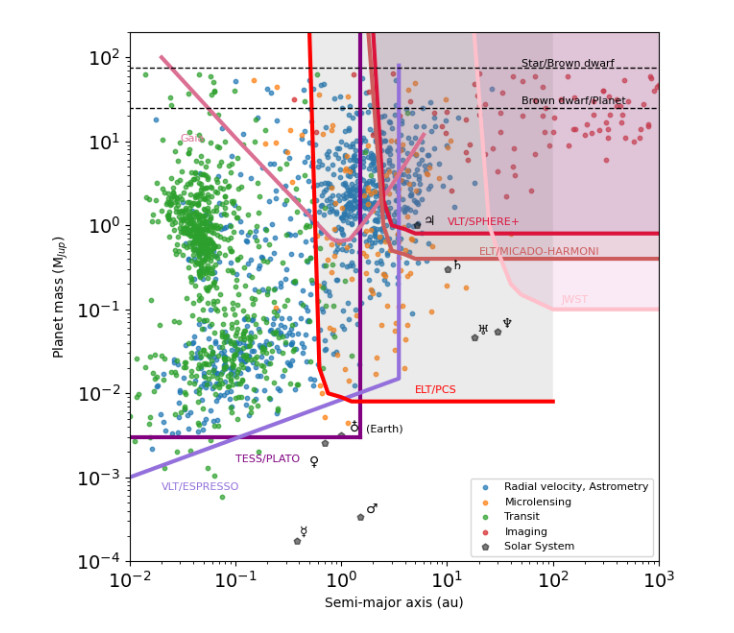Context & Goals
Understanding how giant planets form and evolve, what their internal structure is and what their atmospheres are, is one of the major challenges of modern astronomy, which is directly connected to the ultimate search for life by 2030 - 2040. However, several obstacles in astrophysics (understanding the formation and physics of giant and telluric exoplanets), biological (identification of the best biomarkers) and technological (technical innovations for new generations of telescope and instruments) must be lifted. From an astrophysical point of view, it is indeed crucial to understand the mechanisms of formation and interactions of giant planets which will completely sculpt planetary architectures and therefore dominate the formation of telluric planets, in particular in regions around the host star capable of harboring life. It is also important to develop instrumentation and dedicated techniques allowing to study the population of giant and telluric planets in their entirety, but also to reveal in the near future the first biological markers of life in atmospheres of telluric planets.

In this perspective, the future decade is rich in instrumental projects in space and on the ground exploiting the different techniques of detection and characterization of exoplanets in a complementary manner (see Timeline). Within 5 to 10 years, these large systematic surveys in imagery, astrometry, velocimetry and transit will make it possible to obtain a virtually complete census of exoplanet systems within a horizon of 100 to 200 pc. The prospect of an obser-vational era will then open up essentially dedicated to the physical and atmospheric characterization of known exoplanets. This phase has already been initiated with Hubble and Spitzer, and with the first imagers of exoplanets on the ground (NaCo, SPHERE, GPI, SCExAO, MagAO-X...) will intensify with the arrival of the JWST space telescope (James Webb Space Telescope, scheduled for 2021) which will offer greater sensitivity in transit and in imaging (Clampin and al. 2010), and will eventually accelerate with the new generation of extremely large telescopes GMT (Shect-man et al. 2010), TMT (Simard et al. 2010) and ELT (McPherson et al. 2012), which despite declining sensitivity, by 2026 will offer a unique spatial and spectral resolution, as well as a variable instrumentation over several decades for the characterization of giant and telluric planets and the search for bio-signatures.
In this rich perspective, I have been involved into the early phases of developement and the current scientific preparation of the European ELT, through the defintion of the Topl Level Requirements of the ELT instrumentation with the ESO Project Science Team, and as a member of the science teams of the MICADO, MAORY and HARMONI ELT First Light instruments. I am particularly interested in exploiting the ELT potential toward two main directions of research:
 The study of the physical properties and formation processes of giant planets with the ELT first light instruments, drawing on my expertise in direct imaging and high contrast spectroscopy of the twenty last years combined with an exploitation of other techniques : velocimetry (CRIRES +, ESPRESSO, SPIROU, NIRPS), astrometry (GRAVITY, GAIA) and transit (TESS, CHEOPS, JWST, PLATO), and by preparing and then exploiting the observational domain opened by the first instruments ELT lights, and more particularly by their high contrast mode. With access to contrasts from 106 to 107 for angular resolutions of the order of 50 to 100 mas, direct imaging can: i/ be combined with velocimetry and astrometry techniques to study systematically the same planets and thus constrain mass and luminosity which constrain the formation history of these giant exoplanets, ii/ allow a finer characterization of the physics and atmospheres of the planets giant ice creams of the Saturn and Neptune type with separations greater than a few uas. Within the MAORY-MICADO scientific group, I identified in 2017 the importance of scientific cases dedicated to known young systems and to the monitoring of young exoplanet systems that will be discovered with GAIA (Fiorentino, Bellazzini, Ciliegi, Chauvin et al. 2017). As a member of the scientific team of the ELT, I work in particular on the instrumental and astrophysical roadmap in the field of exoplanets (Chauvin 2018). This involvement is a necessary second step to familiarize very early with the environment and the performance of the most ambitious man-made ground telescope (size, segmentation, integrated adaptive optics).
The study of the physical properties and formation processes of giant planets with the ELT first light instruments, drawing on my expertise in direct imaging and high contrast spectroscopy of the twenty last years combined with an exploitation of other techniques : velocimetry (CRIRES +, ESPRESSO, SPIROU, NIRPS), astrometry (GRAVITY, GAIA) and transit (TESS, CHEOPS, JWST, PLATO), and by preparing and then exploiting the observational domain opened by the first instruments ELT lights, and more particularly by their high contrast mode. With access to contrasts from 106 to 107 for angular resolutions of the order of 50 to 100 mas, direct imaging can: i/ be combined with velocimetry and astrometry techniques to study systematically the same planets and thus constrain mass and luminosity which constrain the formation history of these giant exoplanets, ii/ allow a finer characterization of the physics and atmospheres of the planets giant ice creams of the Saturn and Neptune type with separations greater than a few uas. Within the MAORY-MICADO scientific group, I identified in 2017 the importance of scientific cases dedicated to known young systems and to the monitoring of young exoplanet systems that will be discovered with GAIA (Fiorentino, Bellazzini, Ciliegi, Chauvin et al. 2017). As a member of the scientific team of the ELT, I work in particular on the instrumental and astrophysical roadmap in the field of exoplanets (Chauvin 2018). This involvement is a necessary second step to familiarize very early with the environment and the performance of the most ambitious man-made ground telescope (size, segmentation, integrated adaptive optics).
Publications
Publications fully related to the DUSTIES projects:
-
-
Kasper, M., Cerpa Urra, N., Pathak, P., Bonse, M., Nousiainen, J., Engler, B., Heritier, C. T., Kammerer, J., Leveratto, S., Rajani, C., Bristow, P., Le Louarn, M., Madec, P. -Y., Ströbele, S., Verinaud, C., Glauser, A., Quanz, S. P., Helin, T., Keller, C., Snik, F., Boccaletti, A., Chauvin, G., Mouillet, D., Kulcsár, C., & Raynaud, H. -F. 2021, The Messenger PCS — A Roadmap for Exoearth Imaging with the ELT
-
Carlotti, A., Vigan, A., Bonnefoy, M., Houlé, M., Chauvin, G., Choquet, E., Rameau, J., & Thatte, N. 2019, SF2A-2019: Proceedings of the Annual meeting of the French Society of Astronomy and Astrophysics Spectroimaging of young planets with ELT-HARMONI
-
Chauvin, G. 2018, arXiv e-prints Direct Imaging of Exoplanets at the Era of the Extremely Large Telescopes
-
Fiorentino, G., Bellazzini, M., Ciliegi, P., Chauvin, G., Douté, S., D'Orazi, V., Maiorano, E., Mannucci, F., Mapelli, M., Podio, L., Saracco, P., & Spavone, M. 2017, arXiv e-prints MAORY science cases white book
-
Chauvin, Gael 2013, Proceedings of the Third AO4ELT Conference The EELT's View of Circumstellar Environments
-
Collaborators
MICADO/MAORY teams: Philippe Feautrier, Sylvain Douté, Estelle Moraux, Yann Clénet, Pierre Baudoz, Elsa Huby, Anthony Boccaletti, Raphael Galicher, Clément Perrot
HARMONI team: Alexis Carlotti, Arthur Vigan, Mickael Bonnefoy, David Mouillet
ESO/PST team: Giuseppe Bono (Chair), Yann Alibert, Natascha Forster-Schreiber, Tom Herbst, Isobel Hook, Christoph Keller, Oleg Kochukhov, Carlos Martins, Norbert Przybilla, Roberto Ragazzoni, Agustin Sanchez Lavega, Ric Davies (MICADO PI), Niranjan Thatte (HARMONI PI), Bernhard Brandl (METIS PI), Paolo Ciliegi (MAORY PI),
ESO team: Markus Kasper, Norbert Hubin, Michele Cirasuelo





